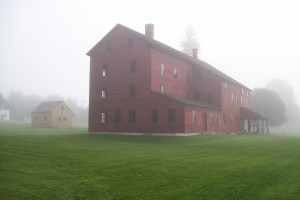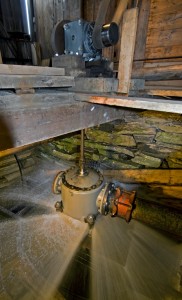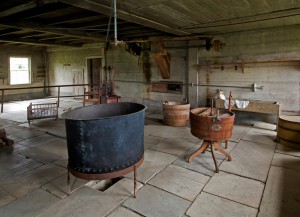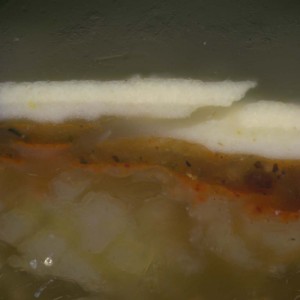 The Laundry/Machine Shop accommodated both Sisters and Brethren’s work. Equipment in the machine shop and washroom was powered by an overshot waterwheel and later by a turbine, fed by the Shakers’ extensive water system.
The Laundry/Machine Shop accommodated both Sisters and Brethren’s work. Equipment in the machine shop and washroom was powered by an overshot waterwheel and later by a turbine, fed by the Shakers’ extensive water system.
Housing both Brethren’s and Sisters’ work under one roof was rare throughout Shaker history due to their belief in gender separation. Machines and equipment in the building ran on a state-of-the-art waterpower system powered by an overshot wheel developed in the Village’s earliest years. This building illustrates not only the separate nature of work carried out by the Brethren and the Sisters, but also the Shaker philosophy of “Hands to Work and Hearts to God.” This saying, attributed to the Shaker founder Mother Ann Lee, stood as a reminder to all Believers that, according to Shaker principles, work and worship, the practical and the spiritual, were inseparable.
 In 1858, always willing and eager to upgrade to the most modern technologies available, the Shakers installed a more advanced water turbine, greatly increasing the efficiency and productivity of the woodworking and laundry activities. The turbine is demonstrated daily to museum visitors. The Machine Shop is a large open room. A section of the floor is partially open to provide access to the turbine. The main shaft is original, but other components have been replaced as the originals were removed for a scrap drive during World War II.
In 1858, always willing and eager to upgrade to the most modern technologies available, the Shakers installed a more advanced water turbine, greatly increasing the efficiency and productivity of the woodworking and laundry activities. The turbine is demonstrated daily to museum visitors. The Machine Shop is a large open room. A section of the floor is partially open to provide access to the turbine. The main shaft is original, but other components have been replaced as the originals were removed for a scrap drive during World War II.
The Laundry/Machine Shop may have begun as a dwelling dating to the 1790s, later adapted to a large utilitarian building positioned over the penstock, or incoming water supply pipe, from the reservoir. The post-and-beam structure is generally clad in clapboard like most building in the Village, with a stone foundation and wooden roof shingles.
 The laundry wash room floor is covered with marble slabs, which slope up at the edges of the walls. A brick stove is built onto the south end of the large fireplace, which is faced with marble slabs. A circular stone base near the east wall marks the location of an early washing machine, operated by the overhead shafts and wheels. There is an ironing room. A central stairway leads to the second story, where wooden drying racks hang from exposed framing, and there are also stairs to the attic.
The laundry wash room floor is covered with marble slabs, which slope up at the edges of the walls. A brick stove is built onto the south end of the large fireplace, which is faced with marble slabs. A circular stone base near the east wall marks the location of an early washing machine, operated by the overhead shafts and wheels. There is an ironing room. A central stairway leads to the second story, where wooden drying racks hang from exposed framing, and there are also stairs to the attic.
CLICK HERE to view a video about the water-powered equipment in the Machine Shop, as featured in Fine Woodworking.
…A Word from our Historic Preservation Team
Paint Analysis in the Laundry & Machine Shop
In 2013, students in the UMass Amherst / Hancock Shaker Village Master of Science in Design and Historic Preservation program took samples (pictured at left) of woodwork and plaster from various laundry rooms. These samples were scientifically analyzed using optical microscopy techniques to discover that most of the woodwork in the washroom was originally unpainted. The peg rail in the stairway and the baseboards in the ironing room had a thin application of deep red-orange oil-based paint. Some surfaces had a coating of plant resin varnish over the the paint. After 1845, the Shakers painted both rooms with an off-white paint that included zinc white.

